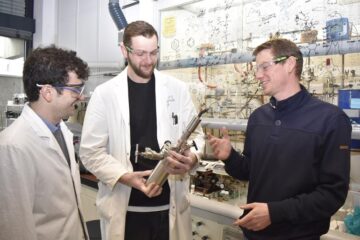MIT team envisions exploring Mars with mini probes

Thousands of probes, powered by fuel cells, could cover a vast area now beyond the reach of today's rovers, including exploring remote and rocky terrain that large rovers cannot navigate.
“They would start to hop, bounce and roll and distribute themselves across the surface of the planet, exploring as they go, taking scientific data samples,” said Steven Dubowsky, the MIT professor of mechanical engineering who is leading the research team.
Dubowsky's team plans to test prototypes on Earth this fall and estimates that a trip to Mars is about 10 years away. He is now working with Penelope Boston, director of the cave research program at the New Mexico Institute of Mining and Technology, to create probes that can handle the rough terrain of Mars.
Scientists believe that lava tubes commonly seen on Mars are a promising location to search for signs of water. Lava tubes are tunnels left behind by underground lava flows. Signs of these tubes, which are also present in many locations on Earth, can be seen above ground.
The tubes could be entered through holes that formed on the Mars surface where sections of the tubes have collapsed, but these formations are too treacherous for today's rovers to explore. However, tiny bouncing probes could make their way inside the caves.
Mars also features canyons that could have once had rivers flowing through them. The canyons, too, are inaccessible to rovers, but small probes might be able to make their way down the canyon faces.
One of the major advantages of the mini probes is that losing a few out of hundreds or thousands of probes sent into a treacherous area would not derail the overall mission, Dubowsky said. “You would certainly be willing to sacrifice some of these 1,000 balls” to gather information from remote areas, he said.
Each probe would weigh about 100 grams (4 ounces) and would carry its own tiny fuel cell. “You could hop for a long, long time on a few grams of fuel,” Dubowsky said.
Artificial muscles inside the probes could make them hop an average of six times per hour, with a maximum rate of 60 hops per hour. The devices would travel about 1.5 meters per hop; they can also bounce or roll. In 30 days, a swarm of probes could cover 50 square miles, according to Dubowsky.
Each probe would carry different types of sensors, including cameras and environmental sensors. The probes are made of durable and lightweight plastic that could withstand the rigors of Mars travel and the extreme cold. Their fuel cells will provide enough heat to keep their electronics and sensors operable.
One thousand of the probes would have the same volume and weight as the Spirit rover. “For the weight and size of Spirit you could certainly send more than 1,000 of these sensors up there, which would have much greater capability,” Dubowsky said.
The probes would be able to communicate with nearby probes through a local area network (LAN). Data would be sent to a base station that would transmit information back to Earth.
Other possible applications for the small robots include search and rescue missions in collapsed buildings or other dangerous sites, and counter-terrorist activities (searching for terrorists in caves).
Last year, the researchers got funding from the NASA Institute for Advanced Concepts (NIAC). The NIAC grant is meant to help move the project from the concept stage to the prototype stage.
Other collaborators on the project include Jean-Sebastien Plante, a postdoctoral researcher in MIT's Department of Mechanical Engineering, and Fritz Prinz and Mark Cutkowsky of Stanford University.
Media Contact
More Information:
http://www.mit.eduAll latest news from the category: Physics and Astronomy
This area deals with the fundamental laws and building blocks of nature and how they interact, the properties and the behavior of matter, and research into space and time and their structures.
innovations-report provides in-depth reports and articles on subjects such as astrophysics, laser technologies, nuclear, quantum, particle and solid-state physics, nanotechnologies, planetary research and findings (Mars, Venus) and developments related to the Hubble Telescope.
Newest articles

Efficient, sustainable and cost-effective hybrid energy storage system for modern power grids
EU project HyFlow: Over three years of research, the consortium of the EU project HyFlow has successfully developed a highly efficient, sustainable, and cost-effective hybrid energy storage system (HESS) that…

Safer alternative for an explosive reaction
The chemical industry has been using a reaction with explosive chemicals for over 100 years – now Mülheim scientists have discovered a safer alternative. The Ritter Group of the Max…

How immune cells communicate to fight viruses
Chemokines are signalling proteins that orchestrate the interaction of immune cells against pathogens and tumours. To understand this complex network, various techniques have been developed to identify chemokine-producing cells. However,…





















